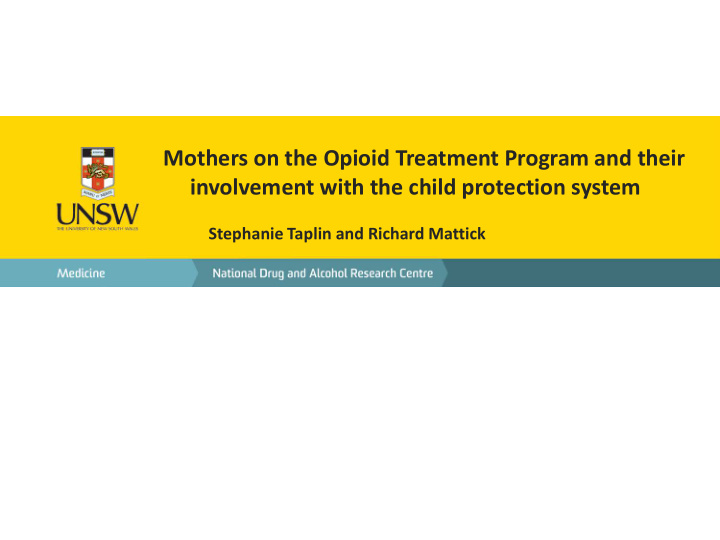



Mothers on the Opioid Treatment Program and their involvement with the child protection system Stephanie Taplin and Richard Mattick
Background to the study • Three year study: Child protection and women in substance abuse treatment. • Funded by NSW Community Services, NDARC & UNSW (2007-2010). • Lack of research in this area. Major aim: To compare mothers on OTP and involved with child protection with those not. And: To describe their characteristics, parenting, children, child protection and AOD interventions.
Why recruit women on the OTP? • Numbers on OTP [6,442 women (34.9%) 2010] • Around half all AOD treatment entries have children; most women entering treatment are mothers of dependent children • Able to recruit mothers not known to child protection • Child protection concerns re heroin use & parenting • OTP allows parents to continue caring for their children
Methods • Women on OTP with children < 16 yrs • Recruited through nine OTP clinics • Public and private clinics across Sydney • 171 women interviewed May 2009 to May 2010 • Estimated 59% response rate • Consent to access treatment and Community Services records (up to 12 months after interview)
Sample demographics Characteristics Sample (n = 171) Age at interview 37 years (median) School years completed Year 10 (median) Indigenous status 22% Aboriginal Relationship status 32% married/de facto Source of income 87% on government benefits Housing 58% living in public housing Driver’s licence 70% had no licence
Major risk factors Characteristics Sample (n = 171) Age first heroin use 19 years (median); range: 10-40 yrs Previous AOD 23 yrs (median) age first treatment treatments 4-5 yrs on OTP this time 39% on psychiatric medication (presc) Mental health Domestic violence 18% had a current AVO Crime 42% had a prison history 65% reported abuse as a child, mostly of Own abuse history more than one type
Children Characteristics Sample Woman’s age of first birth 21 years (median) Range 14 – 43 years 39% teenage mothers Number of children Total: 400 (302 < 16 years) Median: 2 children Range: 1 – 8 children Health or behavioural problems 64/302 children (21%) Opioids or children first? 38% of women started opioid use after their first child
Child protection reports • 64% of mothers reported that one or more of their children had been the subject of a child protection report. • 39% of latest reports made by Health (OTP, maternity ward, other health/medical) • 65% reported for ‘drug or alcohol abuse’
Women’s child protection involvement Child protection Number Percentage system involvement (n = 171) Current * 66 39% (56 with child/ren (33%) in care) Past 43 25% Nil 62 36% • At least one child in care and/or investigation/service within previous 6 months. (Grella, Hser & Huang, 2006)
Out-of-home care (OOHC) • 99 children under age of 16 years were in OOHC, one-third of their children. • Half of those aged 3-4 years were in care. • Not all children from one family in care. • 67% in kinship/relative care (v 51% across NSW). • 42% of those in care were removed at birth; 73% amongst children under 5 years. • Some geographic differences.
Living away from home – not OOHC • Another 57 children under 16 years were not living with their mother • Reasons: Informal arrangements with family (n=42) Family Court orders (n=15).
Do they improve on OTP? Self-reported reductions in: • Illicit drug use (not tobacco, cannabis, alcohol) • Criminal involvement • Number of problem areas • Time spent with illicit drug-using friends Self-reported improvements in: • Parenting ability • Financial situation • Sources of support
Research question Are mothers in drug treatment services who are involved with child protection services different in terms of parenting and other characteristics associated with child maltreatment to those mothers who are not involved?
Areas tested: Comparing mothers currently involved with CP versus those not • Age; age first birth; number children • Schooling; income; financial • Aboriginality • Mental health; domestic violence; • Own abuse & criminal history • Social supports • Drug treatment & heroin use history • Recent substance use
Significant in bivariate analyses: factors associated with child protection involvement (p < 0.01) • Lower level of schooling (< Year 12) • No driver’s licence • Greater number of children • Criminality: recent trouble with police and having a prison history • Lack of social supports: irregular contact with parents and not being able to get help when needed • Extensive substance use history: more AOD treatments, younger age first AOD treatment, and younger age first heroin use.
Significant variables in logistic regression model Variable Odds ratio 95% CI Number of children 1.431 * 1.004, 2.039 Being on ‘psychiatric’ 2.962 * 1.226, 7.157 medication Seeing own parents ** No contact/rarely Monthly/weekly 1.234 0.465, 3.275 Daily 0.220 ** 0.071, 0.676 * p < 0.05; ** p < 0.01
Conclusions from the study • Multiple problems and disadvantages experienced by most women in sample • High level of child protection involvement • Rather than severity of substance use, other factors are of greater importance in child protection involvement • Importance of social supports • First study of this nature in Australia.
Next steps • Funding from NSW Drug & Alcohol Research Grants Program (2011/12) • Twelve month follow-up via child protection records of women who consented at time of interview • Analysis of predictors of child protection involvement after 12 months • Descriptive analyses: new births, interventions, removals, reunifications, reasons • Develop further research.
Acknowledgements • This research was funded by NSW Community Services, NDARC and the University of NSW. Additional assistance was provided by Melissa • De Vel Palumbo, who entered the data while on research placement, and Barbara Toson, Biostatistician, who provided statistical advice. • Particular thanks go to the OTP staff who helped with the study and the women who took part.
Recommend
More recommend